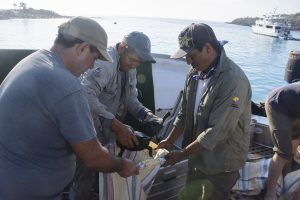
Quito, Apr 20 (EFE).- A total of 190 captive-reared juvenile giant tortoises were released in Ecuador’s Galapagos Islands as part of a project to restore the animals to Santa Fe Island, Galapagos National Park said Thursday.
“This group of tortoises is part of what will be the giant tortoise breeding population. They will be the engineers of the Santa Fe ecosystem and, moreover, today they are an example of what can be implemented with innovative management models,” Galapagos Conservancy representative and expedition leader Washington Tapia said.
The giant tortoises (Chelonoidis hoodensis), which are between 4 and 5 years old, are of the species from Española Island and came from a breeding center on Santa Cruz Island.
A team of 26 Galapagos National Park rangers, Galapagos Conservancy scientists and volunteers began releasing the tortoises early Monday as part of the Giant Tortoise Restoration Initiative (GTRI).
“With their food patterns and their movement, these new tortoises of Santa Fe will contribute to the complete restoration of the island. It is possible that in a few years we will see this place as it originally was,” Galapagos National Park director Walter Bustos said.
Veterinarians examined the tortoises before their release and determined that all the animals were healthy.
“The newly released tortoises join a group of 201 young Española tortoises released there in 2015 (and another four released in 2016), and will help play the important role of ‘ecosystem engineers’ as the largest herbivores on the island,” the Galapagos Conservancy said in a statement.
Santa Fe Island’s original tortoise population went extinct more than 150 years ago.
The Galapagos Islands are located about 1,000 kilometers (600 miles) west of the coast of continental Ecuador and were declared a World Natural Heritage Site in 1978.
Some 95 percent of the territory’s 8,000 sq. kilometers (a little over 3,000 sq. miles) constitutes a protected area that is home to more than 50 species of animals and birds found nowhere else on the planet.
The islands were made famous by 19th-century British naturalist Charles Darwin, whose observations of life on the islands contributed greatly to his theory of the evolution of species.
